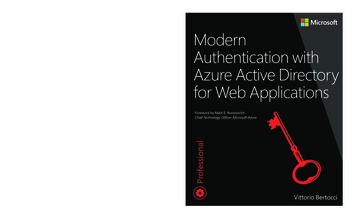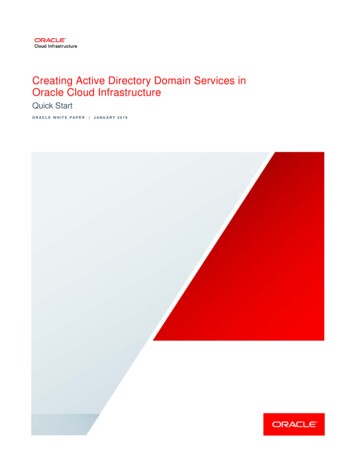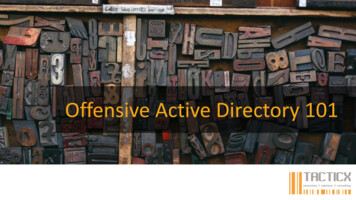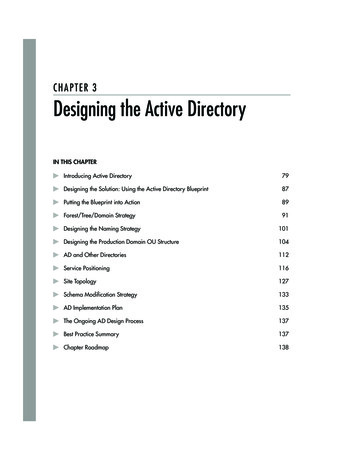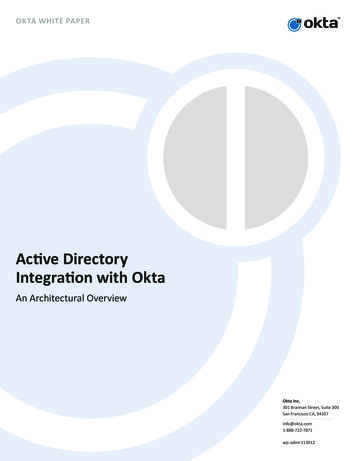
Transcription
OKTA WHITE PAPERActive DirectoryIntegration with OktaAn Architectural OverviewOkta Inc.301 Brannan Street, Suite 300San Francisco CA, 94107info@okta.com1-888-722-7871wp-adint-113012
Table of Contents1 Active Directory and the Cloud: An Overview3 Active Directory and Cloud Applications with Okta4 Okta Active Directory Integration for All Your Cloud Apps5 Simple and Secure Setup and Configuration7 Intelligent User Synchronization8 Just-in-Time User Provisioning8 Simple-to-Use Delegated Authentication10 Desktop Single Sign-On11 Self Service Password Reset Support11 Security Group–Driven Provisioning12 One-Click Deprovisioning12 Single Sign-On for AD Authenticated Apps13 Conclusion—Extend Active Directory to the Cloud with Okta13 Okta Active Directory Agent Details14 Okta IWA Web Application Details14 About OktaActive Directory Integration with Okta
Active Directory and the Cloud: An OverviewFor most companies, Microsoft Active Directory (AD) plays the central role incoordinating identity and access management policies. AD typically serves as a “sourceof truth” for user identities, and it provides access control to on-premises resourcessuch as networks, file servers, and web applications (see Figure 1). When on-premisesapplications are integrated to Active Directory, users get the best possible experience:they log in to their domain once and are granted access to the appropriate resources.Administrators benefit too—they maintain clear control over who has access to what.This model is ubiquitous because it works well with LAN-based architectures (whereapplications are served from hardware inside the firewall). But as we’ll show, thisapproach begins to break down as enterprises shift to cloud-based applications,and a new solution is needed.Figure 1: Active Directory for on-premisesapplication user identitiesA byproduct of the transition to cloud applications is the proliferation of separate userstores; each cloud application typically is rolled out independently and thereforehas its own unique database of user credentials (see Figure 2). This is a minor nuisancewith only one or two applications, but as companies adopt more and more cloudapplications, administrators are faced with an unmanageable number of differentuser directories. And this problem is only getting bigger. Users’ passwords proliferatewith each new application, and administrators quickly lose control over who hasaccess to what. Worse still, when an employee leaves, most companies cannot easilyand accurately identify which accounts to deactivate, nor do they have any auditingcapabilities to ensure the necessary deprovisioning occurs in a timely manner.Active Directory Integration with Okta 1
Figure 2: Adoption of cloud applicationsleads to proliferation of user storesOne solution to the problem of independent user store proliferation is to attempt tointegrate all cloud applications to a single, shared identity store (see Figure 3).Active Directory is by far the most convenient option for this, as it can provide identitymanagement for both on-premises and cloud-based applications. Some cloud applicationvendors provide APIs or toolkits that allow enterprises to try to connect the application’sstandalone identity stores to Active Directory. However, integration via APIs requirescustom development, and each of the toolkits is different and can often requiresignificant investment in setup, equipment (hardware to run the connector software),and maintenance as the applications change over time. As the number of cloudapplications increases, this model of per-app AD integrations becomes prohibitivelyexpensive. There is always the next new application that the business needs to run.Active Directory and Cloud Applications with OktaFigure 3: Integrating AD with multiple cloudapplications is costly and difficult to maintainActive Directory Integration with Okta 2
Okta’s cloud-based identity and access management service solves these problems witha single integration point that provides a highly available solution for all cloud and webbased application AD integrations.Okta eliminates the pitfalls that come with trying to build and manage multiple onpremises AD integrations yourself:Pitfall of DIY AD integrationsOkta ApproachDo you have the correct skillsetto develop these integrations?With Okta, integrations do not requireprogramming or development experienceand can be accomplished in minutesthrough our easy-to-use interface.How will you upgrade andmaintain integrations?Okta works with ISVs and monitors changesand upgrades to existing APIs to take advantageof the latest functionality; we release updatesweekly to reflect changes.How do you monitor the healthof the integration?Okta continuously monitors and tests existingintegrations to ensure that the integrationfunctions as expected after upgrades and releases.Which protocol will you use to connectto each cloud application?Okta eliminates the need to know SAML,OAuth, SCIM, and numerous otherintegration protocols, because Oktamanages these integrations for you.What happens when the server running yourhome-grown, toolkit-based integration fails?Okta automatically enables failover recoverywith a redundant-agent architecture.How will you integrate your cloud app witha multiple domain AD configuration?Okta has built-in support for multipleAD domain environments.What firewall changes are needed foreach cloud app-to-AD integration?With Okta, there are no firewall changesneeded to support AD integration.Can your users reset their AD password easily?Okta includes a self service password reset optionthat saves users and IT admins time and money.Once in place, Okta provides an infrastructure that allows companies to freely pursuenew cloud applications while still leveraging Active Directory for their employee useridentities. This allows users to access any cloud app using their existing AD credentials;it enables IT admins to control access to those applications from a single control panel;and it combines AD security groups with individual user assignments.Active Directory Integration with Okta 3
Okta Active Directory Integrationfor All Your Cloud AppsOkta offers a complete and easy-to-use Active Directory integration solution forcloud and on-premises web applications. The Okta on-demand Identity and AccessManagement service provides user authentication, user provisioning and de-provisioning,and detailed analytics and reporting of application usage, for both cloud applications andon-premises web applications. A key component of this service is Okta’s AD integrationcapability, which is very easy to set up and is architected for high availability. In addition,Okta maintains the integrations for you, with thousands of applications supported inOkta’s Application Network.For AD integration, Okta provides two lightweight and secure on-premises components: Okta Active Directory Agent: A lightweight agent that can be installed on anyWindows Server and is used to connect to on-premises Active Directory for userprovisioning, de-provisioning, and authentication requests. Okta Integrated Windows Authentication (IWA) Web Application: A lightweight webapplication that is installed on an Internet Information Services (IIS) and is used toauthenticate domain users via Integrated Windows Authentication.The Okta AD Agent and the Okta IWA Web App combine with the Okta cloud service itselfto form a highly available, easy to set up and maintain architecture that supports multipleuse cases. This paper provides additional details about this flexible architecture.Figure 4: Okta for Active Directory architecture:one integration for all web applicationsActive Directory Integration with Okta 4
Okta’s AD Integration offers the following: Simple and Secure Setup Up and Configuration Intelligent User Synchronization Just- in- Time User Provisioning Robust Delegated Authentication Integrated Desktop Single Sign-On (SSO) Self Service Password Reset Support AD Security Group-driven Provisioning Automated One-Click De-provisioning Single Sign-On for AD Authenticated AppsSimple and Secure Setup and ConfigurationWith Okta, enabling AD integration is a simple wizard-driven process. With one clickfrom the Okta administrative console, you can download the Okta Active Directoryagent and install it on any Windows Server that has access to your Domain Controller.The Okta AD Agent runs on a separate server from your domain controller.Figure 5: The Active Directory installation processActive Directory Integration with Okta 5
During installation, you simply enter your Okta URL and AD Administrator credentialsand the Okta AD Agent creates a low-privileged, read-only integration accountand then securely establishes a connection with your Okta instance—no network orfirewall configuration required.The Okta AD Agent connects to Okta’s cloud service using an outbound port 443 SSLconnection. This connection is cycled every 30 seconds to ensure compatibility with anyexisting firewalls or other security devices. As a rule of thumb, if a user can log into thehost machine using AD credentials and can access the Internet from a browser, the OktaAD Agent will work successfully and will require no firewall changes.Figure 6: Okta AD Agent connection is SSL encryptedover Port 443. No firewall changes needed.Communication with the Okta AD Agent is secured using SSL andmutual authentication, specifically: Okta AD Agent to Okta Service: The Agent authenticates the service by validatingthe Okta server SSL cert for mycompany.okta.com. The service authenticates theAgent using a security token given to the Agent on registration. The registrationprocess requires Okta administrator credentials before generating the securitytoken. The security token is specific to each Agent and can be revoked at any time. Okta AD Agent to Domain Controller: The Agent authenticates with the DomainController using the low-privileged, read-only integration account that wascreated during the agent install process.Active Directory Integration with Okta 6
Intelligent User SynchronizationOnce the Okta AD Agent is installed and the initial user import takes place, Oktaintelligently processes the results of the user import. Matching algorithms are appliedto analyze the incoming AD users and to determine if there is a match to existing Oktausers or to accounts that you have imported from other cloud systems (e.g., GoogleApps). Future user imports can be set to a schedule or performed on demand.Figure 7: The Active Directory import processAdding a UserWhen a user is added to Active Directory, the new object is detected by the OktaAD Agent and automatically added to the Okta service. Only necessary fields aretransmitted, including name, UPN, SAMAccountName, email address, and securitygroup membership.The Okta AD Agent never sends passwords to Okta’s cloud service. Existing accountsin managed apps such as Salesforce.com or WebEx can be imported and automaticallymatched against Active Directory users based on explicit rules or heuristic matching.Active Directory Integration with Okta 7
Just-in-Time User ProvisioningAs noted above, user provisioning is very simple when Okta’s AD integration inplace: any new users added to AD are automatically provisioned to Okta and totheir designated cloud and web-based applications.However, Okta has an additional option to provision users even faster: just-in-timeprovisioning. With just-in-time provisioning, IT admins can allow new users to beautomatically created in Okta provided they already exist in Active Directory.In this way, valid AD users can provision themselves automatically into Okta(and to the appropriate cloud applications as a result).The process for just-in-time provisioning is:1. A user who previously was not provisioned in the Okta service attempts tolog in to mycompany.okta.com.2. Okta and the Okta AD Agent check the user credentials against Active Directory.3. If the user is active in AD, a new user account is automatically created in Okta.The new user account leverages their existing AD credentials.4. Depending on their AD security group attributes, the user is automaticallyprovisioned to downstream cloud and web applications via the Okta service.Just-in-time provisioning allows IT admins to increase user adoption of both theOkta service and of all assigned cloud applications, while leveraging the ADcredentials that their users already know.Simple-to-Use Delegated AuthenticationOkta’s AD integration support also allows you to delegate the authentication of usersinto Okta to your on-premises AD Domain instead. That is, user login attempts tomycompany.okta.com will be checked against Active Directory for authentication. Userscan then easily log into Okta using their Okta user name and Active Directory password.More specifically, the process is:1. The user types his user name and password into the Okta user home page.This login page is protected with SSL and a security image to prevent phishing;multi-factor authentication (extra security question or smartphone softtoken) can be enabled as well.2. The user name and password are transmitted to an Okta AD Agentrunning behind the firewall over the SSL connection that had beenpreviously been established during setup.Active Directory Integration with Okta 8
3. The Okta AD Agent passes those credentials to the AD DomainController for authentication.4. The AD Domain Controller responds with a yes/no answer, validatingthe user name and password.5. The yes/no response is transmitted back to the Okta service by theOkta AD Agent. If yes, the user is authenticated and sent to his OktaMy Applications user home page.Figure 8: Delegated authenticationto Active DirectoryThe user experience for Delegated Authentication to AD is simple:1.Log in to Okta home page; launch app2. Okta looks to AD to authenticate users3. If valid, Okta SSOs in to cloud appsBecause this feature governs user access into Okta, the architecture supports multipleOkta AD Agents running in your environment to provide redundancy. If one of the OktaAD Agents stops running or loses network connectivity, the authentication requests areautomatically routed to the other Okta AD Agents.With this authentication mechanism, the user’s password is never stored in the Oktaservice and Active Directory is maintained as the immediate and ultimate sourcefor credential validation. Because AD is always relied upon for user authentication,changes to the user’s status (such as password changes or deactivations) are reflectedimmediately in the Okta service.Active Directory Integration with Okta 9
Desktop Single Sign-OnOkta supports Desktop Single Sign-On, extending local users’ Windows domainlogin procedures to grant access to Okta and to their cloud applications. Okta’s ADintegration uses Microsoft’s Integrated Windows Authentication to seamlesslyauthenticate users to Okta that are already authenticated via their Windows domainlogin. You simply download and install Okta’s IWA web application, configure therelevant IP ranges, and the setup is complete.Figure 9: Desktop SSO withOkta IWA web applicationThe behind-the-scenes steps that enable seamless login to the Okta servicevia Desktop Single Sign-On (shown in Figure 9) are:1. User navigates to https://mycompany.okta.com.2. The user is redirected to the locally installed IWA web application.3. The IWA web application transparently authenticates the uservia Integrated Windows Authentication (Kerberos).4. The user is redirected back to the Okta login page withcryptographically signed assertions containing his AD user identity.5. The Okta service validates the signed assertions and sends theuser directly to his Okta home page.Note that all of the above steps are transparent to the user. The user experienceis simple: navigate to https://mycompany.okta.com and then land immediately onthe user home page containing links to all of his assigned applications. Alternatively,a user can simply click a link corresponding to a particular application and then beautomatically signed in to that application. The authentication to AD behind thescenes is transparent to the user.Lastly, remote users or users out of the office continue to find and SSO into allof their cloud applications by simply visiting the Okta user home page.Active Directory Integration with Okta 10
Self Service Password Reset SupportYour users can also change their Active Directory password via Okta. When a user’sAD password expires or is reset they will automatically be prompted to change it thenext time they log in to Okta. Users can also proactively change their AD passworddirectly from the account tab on their Okta homepage, and Okta keeps all of thesecredentials synchronized with AD.Security Group–Driven ProvisioningOkta’s service has a group feature that can be used to drive bulk applicationprovisioning and assignments to Okta users according to what groups they aremembers of. Okta allows you to map Active Directory’s security groups to nativeOkta groups and, as a result, to automatically provision applications to usersbased on their membership within AD security groups.When you add a user to AD, you can place him in a security group, and duringautomatic synchronization with Okta, that user will be added, and accounts in theapplications mapped to that security group will be automatically provisioned on theirbehalf. Application-specific parameters such as role, profile, and user information areautomatically set based on rules defined within the Okta service as well. For example, arule can be defined within Okta that ensures that all members of the AD security group“Sales” are provisioned an account in Salesforce.com and given access to it.The result is that when a user is added to Active Directory, all of the tasks requiredto give him access to his cloud and web-based applications are handled automatically.This greatly reduces the provisioning time for new employees, and allows IT admins tocontinue to use AD as their starting point for user access.When a user’s Security Group membership changes, the change is detected by theOkta AD Agent and is relayed to the Okta Service. When this happens, the assignmentrules are recomputed. These rules trigger applications to be newly assigned, existingapplication assignments to be removed, or user properties to be updated on thedownstream applications.New and updated application assignments work exactly the same. All of the stepsto provision the account, set up SSO, and update the user’s My Applications home pageare handled automatically. Deletions are handled similarly. If a user’s access to an appis removed, he is immediately locked out from using SSO to access that application.The application account is then deactivated by the Okta service, or if that cannotbe done automatically, an administrative task is created that must be cleared oncethe account has been deactivated manually. All of these actions can executeautomatically or after confirmation by an Okta administrator.Active Directory Integration with Okta 11
One-Click DeprovisioningUser deactivation is typically triggered from a standard corporate identity store suchas Active Directory. With Okta’s centralized deprovisioning, deactivating a user in ADimmediately initiates a deprovisioning workflow to ensure maximum effectiveness inpreventing unauthorized access to Okta and other cloud applications. The workflowgenerates a notification to administrators and guides IT to complete any necessarymanual deprovisioning tasks associated with a particular user or application. Further,this workflow also serves as an audit trail; within Okta the entire audit trail iscaptured for reporting and audit purposes so that you can easily generatehistorical deprovisioning reports by user or by application.Figure 10: Okta enables SSO for ADauthenticated internal web applicationsSingle Sign-On for AD Authenticated AppsMost
and the Okta AD Agent creates a low-privileged, read-only integration account and then securely establishes a connection with your Okta instance—no network or firewall configuration required. The Okta AD Agent connects to Okta’s
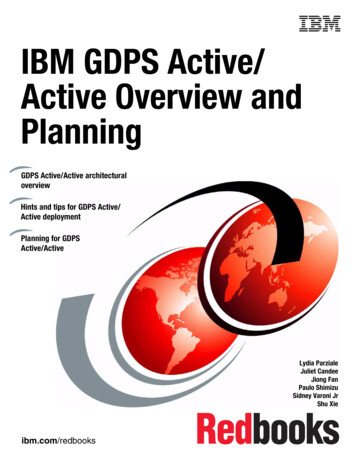
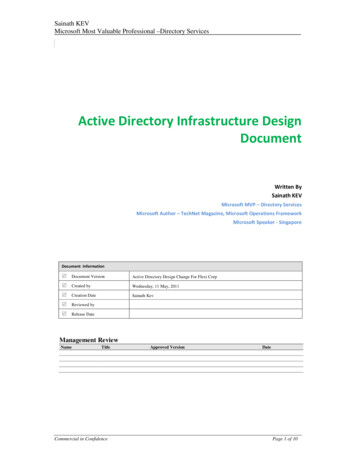
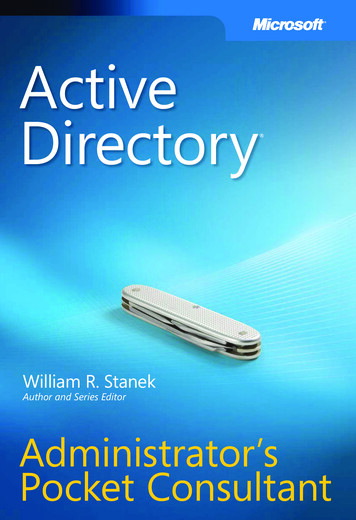

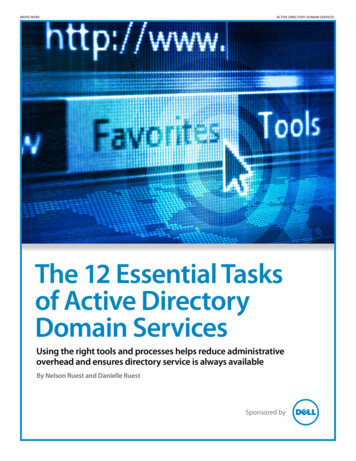
![[MS-ADFSOD]: Active Directory Federation Services (AD FS .](/img/1/5bms-adfsod-5d.jpg)
